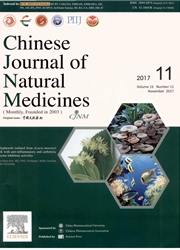

 中文摘要:
中文摘要:
The present study was designed to establish a suitable assay to explore CCR2 b receptor antagonists from the natural products of Artemisia rupetris and Leontopodium leontopodioides. An aequorin assay was developed as a cell-based assay suitable for 384-well microplate and used for screening CCR2 b receptor antagonists from natural products. Through establishing suitable conditions, the assay was shown to be suitable for screening of CCR2 b receptor antagonists. Seven compounds were identified in preliminary screening. Five of them showed evident dose-response relationship in secondary screening. The structure–activity relationship study suggested that 7-position hydroxyl group of flavonoids was necessary, a polar group should be introduced on the 3-position, and the substituents on 2-position benzene ring of flavonoids have little influence on the potentency of the inhibition activity on CCR2 b receptor. The ortho-position dihydroxyl structure in quinic acid compounds may be important. In conclusion, Compounds HR-1, 5, 7, and AR-20, 35 showed activity as antagonist of CCR2 b receptor, which shed lights on the development of novel drugs as CCR2 b receptor antagonists for preventing inflammation related diseases.
 英文摘要:
英文摘要:
The present study was designed to establish a suitable assay to explore CCR2b receptor antagonists from the natural products ofArtemisia rupetris and Leontopodium leontopodioides. An aequorin assay was developed as a cell-based assay suitable for 384-well microplate and used for screening CCR2b receptor antagonists from natural products. Through establishing suitable conditions, the assay was shown to be suitable for screening of CCR2b receptor antagonists. Seven compounds were identified in preliminary screening. Five of them showed evident dose-response relationship in secondary screening. The structure--activity relationship study suggested that 7-position hydroxyl group of flavonoids was necessary, a polar group should be introduced on the 3-position, and the substituents on 2-position benzene ring of flavonoids have little influence on the potentency of the inhibition activity on CCR2b receptor. The ortho-position dihydroxyl structure in quinic acid compounds may be important. In conclusion, Compounds HR-1, 5, 7, and AR-20, 35 showed activity as antagonist of CCR2b receptor, which shed lights on the development of novel drugs as CCR2b receptor antagonists for preventing inflammation related diseases.
 同期刊论文项目
同期刊论文项目
 同项目期刊论文
同项目期刊论文
 期刊信息
期刊信息
